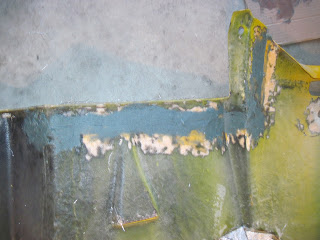In order to connect to the EV04 data system using my computer, the data system comes with a USB cable that has a binder connector which connects to the system and a male Type A USB connector which plugs into the computer. This works fine but the data system in my car is not going to be easily accessible and I didn't like the idea of having a loose cable in the car. So I did some searching on the internet and found a panel mounted USB adapter. The one pictured below happens to be Type A to Type B but I have a Type A to Type B cable so the adapter works fine for what I need. With this adapter in place, the USB cable from the data system will be permanently plugged into the adapter and I can then plug the computer into the data system using the Type A to Type B cable.
Here is the adapter installed. Unfortunately I didn't do a very good job of cutting the hole for it so I covered up gaps with some black electical tape. The tape shows up a lot more in the picture versus in person -- which is a good thing. :>)
One challenging thing about installing a data system in a small formula car is doing something with all the cables. More sensors means more cables and they are never the exact length that you need them. This is one reason why I installed the system where I did. I figured it would give me enough room to store the cables. Of course I also need to cover all of those cables up and the fiberglass cover that came with the car was not going to do the trick. So I decided to make a new cover out of aluminum. But first I needed to get the shape and the easiest way I could think of to do that was to use a thin piece of 1/2" steel scrap that I could easily bend to the shape that I wanted.
After I had that piece made, making the aluminum piece was pretty simple. It will also serve as a nice sturdy piece that the seat can rest up against.
The next data system task was installing the display on my steering wheel. I'm using the steering wheel that I had in my Formula Vee and since I used an AIM system with the same type of display in that car, the steering wheel was already cut for the display. Also, the person I bought the EV04 system from had made a bracket to hold the display and that worked well too.
I was also able to purchase a used AIM Smarty Cam that will not only give me video but it will also give me data overlayed on the video which will be a great learning tool.
I also needed to install the GPS sensor that came with the EV04 system as well as the GPS sensor that came with the Smarty Cam. The will work through fiberglass so I figured the easiest thing to do was to place them on top of the ECU and secure them with some velcro.
The only that is left for me to do on the data system installation is connect the brake pressure sensors and the fuel temperature sensor. I ran out of patch cables so I had to order a few more.

































